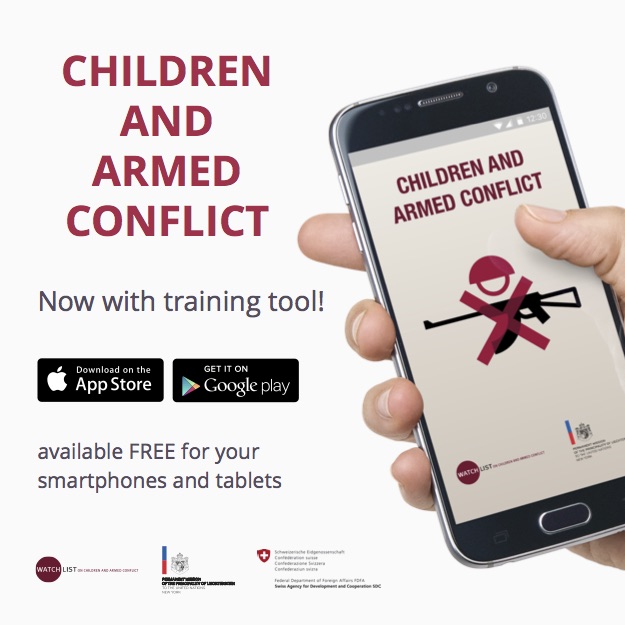On 3-20 November 2013, Watchlist conducted a field mission to the Democratic Republic of Congo (DRC). One objective of the mission was to analyze opportunities and challenges in implementing the UN-led Monitoring and Reporting Mechanism (MRM) in DRC.
Watchlist’s visit took place one year after the Government signed an Action Plan with the UN, on 4 October 2012, to end and to prevent the recruitment and use of children, as well as sexual violence, by the Congolese armed forces (FARDC). The adoption of the Action Plan offered a unique opportunity to disseminate the Government’s commitments to end child recruitment and use, yet the general impression is that the content of the Action Plan had not been given a lot of publicity outside of Kinshasa. These commitments or governmental orders aimed to protect children also have the potential to significantly strengthen the advocacy position of NGOs, yet many of them reported not knowing about or using the official documents. The UN Country Task Force on Monitoring and Reporting (CTFMR) should coordinate with national and international NGOs to disseminate commitments or directives, especially with local commanders located in remote areas where access to information is very limited.
The Action Plan Mid-Term Review, recently prepared by the Government, is another important development allowing the UN and the Government to evaluate progress made towards Action Plan implementation. The outcome of the Mid-Term Review should be used as the starting point for the UN and the Government to develop a ‘Road Map’ towards the finalization of the Action Plan. In Chad and Afghanistan, short and action-oriented ‘Road Maps’ were used to establish clear, measurable benchmarks, allowing donors, governments and the UN Country Teams to prioritize and coordinate their intervention.
Programmatic response:
Data recorded through monitoring of grave violations can be used to inform programmatic response. The CTFMR is in a privileged position to conduct analysis on the typologies of violations, their causes and consequences, and to suggest programmatic priorities in response.[1] However, the sample of cases captured by the mechanism in DRC is not significant enough to make meaningful conclusions on the prevalence rate of occurrence of violations. Therefore, many NGOs have expressed their discomfort with the UN’s use of MRM data to make generalized conclusions regarding the prevalence rate of a given violation over time.
In interviews, many NGOs have expressed their frustrations about the difficulties to properly respond to reported cases of grave violations. While the MRM as such does not have a programmatic response component, the mechanism still has a key role to play in linking reported cases with appropriate referral pathways.[2] However, understanding the role of the CTFMR as catalyst and enabler, with the responsibility to coordinate rather than implement response, may help dissipate some of the frustrations.
Coordination:
Effective coordination efforts have the potential to strengthen the overall impact of the MRM by mobilizing child protection actors in a concerted effort to achieve a common goal. MRM-related activities mostly take place through the Child Protection Working Group (CPWG) at the provincial and regional level. Many NGOs have described the approach adopted by the CPWG as being UN-centric (concentrating on UN needs, as opposed to NGO expectations) and often failing to create NGO ownership and involvement.
In order to improve NGO participation in UN-led humanitarian coordination, attention must be paid to their needs, expectations and grievances. MRM coordination should go beyond collecting primary data from NGOs, and include data analysis, trend analysis, identification of programmatic priorities, the development of clear pathways for response, coordination of advocacy activities, and feedback on how the information collected is being used, as well as the results of those actions. Many NGOs and UN actors mentioned the potential usefulness of a coordination space specific to 1612 implementation if it met with the above-mentioned requirements.
Communication:
Good communication with NGO partners helps encourage ownership. Many NGOs reported that the CTFMR and the MRM focal points should provide more systematic feedback to partners who are taking significant risks to collect and share data on grave violations. Regular feedback will help NGOs to appreciate the impact if their work and remain motivated while allowing them to close the feedback loops with communities.
Finally, some NGOs expressed confusion on the division of roles and responsibilities between UNICEF and MONUSCO’s Child Protection Section in implementing the MRM. This was noted especially with regard to information sharing and data management. The development of an information management guideline by the CTFMR could contribute to clarify a chain of communication where key focal points are attributed specific roles and responsibilities, including coordinating response and completing the feedback loop with NGO partners and communities.
[1] The report on ‘Child Recruitment by Armed Groups in DRC, published in October 2013 by MONUSCO’s Child Protection Section is a good example of MRM-based analysis that could be used to generate broader discussion within the humanitarian community. See: https://monusco.unmissions.org/LinkClick.aspx?fileticket=DazRcHfpAJo%3d&tabid=10701&mid=13689&language=en-US
[2] Filed Manual – The Monitoring and Reporting Mechanism (MRM) on Grave Violations Against Children in situations of Armed Conflict, United Nations Children’s Fund (UNICEF), March 2012, page 14 available at https://www.unicefinemergencies.com/downloads/eresource/docs/2.6%20Child%20Protection/MRM%20Field%20Manual%20English.pdf



